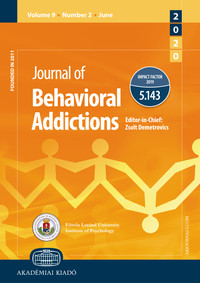Aberrant posterior superior temporal sulcus functional connectivity and executive dysfunction in adolescents with internet gaming disorder
Aberrant posterior superior temporal sulcus functional connectivity and executive dysfunction in adolescents with internet gaming disorder
Author(s): Junghan Lee, Deokjong Lee, Kee Namkoong, Young-Chul JungSubject(s): Behaviorism
Published by: Akadémiai Kiadó
Keywords: Internet gaming disorder; executive dysfunction; posterior superior temporal sulcus; social brain network; adolescence
Summary/Abstract: Background and aims. The clinical significance of Internet gaming disorder (IGD) is spreading worldwide, but its underlying neural mechanism still remains unclear. Moreover, the prevalence of IGD seems to be the highest in adolescents whose brains are in development. This study investigated the functional connectivity between large-scale intrinsic networks including default mode network, executive control network, and salience network. We hypothesized that adolescents with IGD would demonstrate different functional connectivity patterns among large-scale intrinsic networks, implying neurodevelopmental alterations, which might be associated with executive dysfunction. Methods. This study included 17 male adolescents with Internet gaming disorder, and 18 age-matched male adolescents as healthy controls. Functional connectivity was examined using seed-to-voxel analysis and seed-to-seed analysis, with the nodes of large-scale intrinsic networks used as region of interests. Group independent component analysis was performed to investigate spatially independent network. Results. We identified aberrant functional connectivity of salience network and default mode network with the left posterior superior temporal sulcus (pSTS) in adolescents with IGD. Furthermore, functional connectivity between salience network and pSTS correlated with proneness to Internet addiction and self-reported cognitive problems. Independent component analysis revealed that pSTS was involved in social brain network. Discussion and conclusions. The results imply that aberrant functional connectivity of social brain network with default mode network and salience network was identified in IGD that may be associated with executive dysfunction. Our results suggest that inordinate social stimuli during excessive online gaming leads to altered connections among large-scale networks during neurodevelopment of adolescents.
Journal: Journal of Behavioral Addictions
- Issue Year: 9/2020
- Issue No: 3
- Page Range: 589-597
- Page Count: 9
- Language: English

